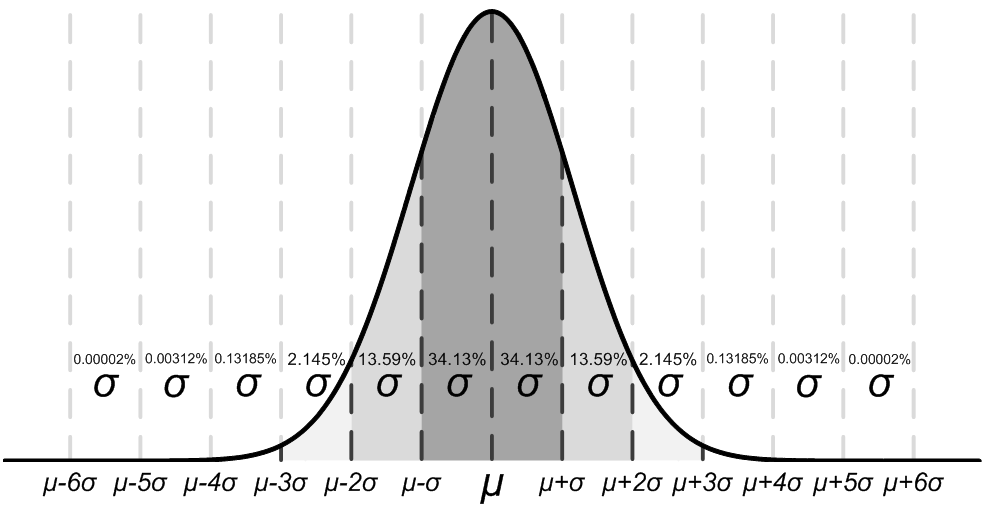SBOSAA0C november 2021 – may 2023 INA350
PRODUCTION DATA
- 1
- 1 Features
- 2 Applications
- 3 Description
- 4 Revision History
- 5 Device Comparison Table
- 6 Pin Configuration and Functions
- 7 Specifications
- 8 Detailed Description
- 9 Application and Implementation
- 10Device and Documentation Support
- 11Mechanical, Packaging, and Orderable Information
Package Options
Mechanical Data (Package|Pins)
Thermal pad, mechanical data (Package|Pins)
- DSG|8
Orderable Information
8.3.4 Typical Specifications and Distributions
Designers often have questions about a typical specification of an amplifier in order to design a more robust circuit. Due to natural variation in process technology and manufacturing procedures, every specification of an amplifier will exhibit some amount of deviation from the ideal value, like an amplifier's input offset voltage. These deviations often follow Gaussian (bell curve), or normal distributions, and circuit designers can leverage this information to guard band their system, even when there is not a minimum or maximum specification in the Electrical Characteristics table.
 Figure 8-4 Ideal Gaussian Distribution
Figure 8-4 Ideal Gaussian DistributionFigure 8-4 shows an example distribution, where µ, or mu, is the mean of the distribution, and where σ, or sigma, is the standard deviation of a system. For a specification that exhibits this kind of distribution, approximately two-thirds (68.26%) of all units can be expected to have a value within one standard deviation, or one sigma, of the mean (from µ – σ to µ + σ).
Depending on the specification, values listed in the typical column of the Electrical Characteristics table are represented in different ways. As a general rule, if a specification naturally has a nonzero mean (for example, like gain bandwidth), then the typical value is equal to the mean (µ). However, if a specification naturally has a mean near zero (like input offset voltage), then the typical value is equal to the mean plus one standard deviation (µ + σ) in order to most accurately represent the typical value.
You can use this chart to calculate approximate probability of a specification in a unit; for example, the INA350 typical input voltage offset is 200 µV, so 68.2% of all INA350 devices are expected to have an offset from –200 µV to +200 µV. At 4 σ (±800 µV), 99.9937% of the distribution has an offset voltage less than ±800 µV, which means 0.0063% of the population is outside of these limits, which corresponds to about 1 in 15,873 units.
Specifications with a value in the minimum or maximum column are assured by TI, and units outside these limits will be removed from production material. For example, the INA350 family has a maximum offset voltage of 1.2 mV at 25°C, and even though this corresponds to 6 σ (≈1 in 500 million units), which is extremely unlikely, TI assures that any unit with larger offset than 1.2 mV will be removed from production material.
For specifications with no value in the minimum or maximum column, consider selecting a sigma value of sufficient guard band for your application, and design worst-case conditions using this value. As stated earlier, the 6-σ value corresponds to about 1 in 500 million units, which is an extremely unlikely chance, and could be an option as a wide guard band to design a system around. In this case, the INA350 family does not have a maximum or minimum for offset voltage drift, but based on Figure 7-2 and the typical value of 0.6 µV/°C in the Electrical Characteristics table, it can be calculated from that the 6-σ value for offset voltage drift is about 2 µV/°C. When designing for worst-case system conditions, this value can be used to estimate the worst possible offset drift without having an actual minimum or maximum value.
However, process variation and adjustments over time can shift typical means and standard deviations, and unless there is a value in the minimum or maximum specification column, TI cannot assure the performance of a device. This information should be used only to estimate the performance of a device.